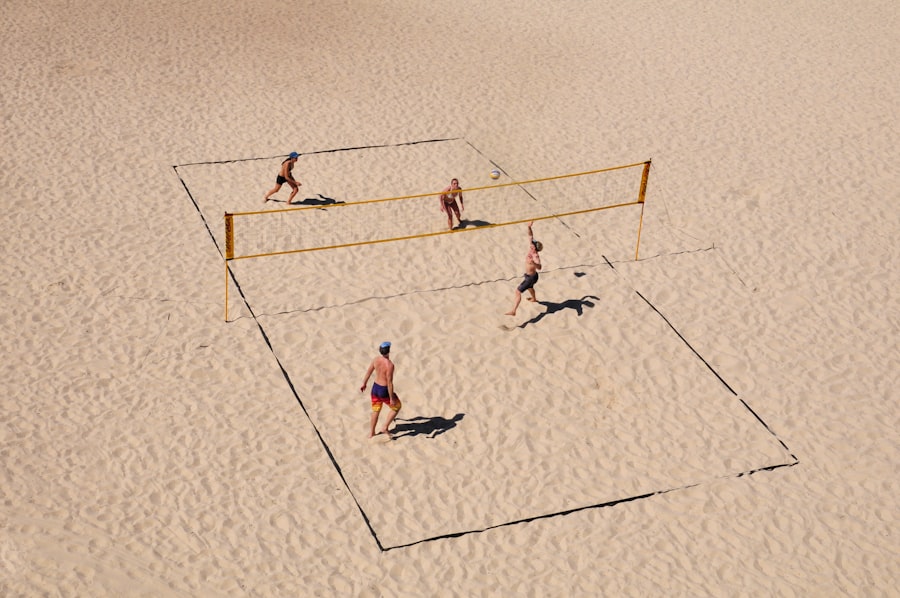Download links
How to install Mastering the Art of Volleyball: Tips for Success APK?
1. Tap the downloaded Mastering the Art of Volleyball: Tips for Success APK file.
2. Touch install.
3. Follow the steps on the screen.
Description
Volleyball is a dynamic and fast-paced sport that has captivated millions around the globe. Originating in the United States in 1895, it has evolved into a highly competitive game played both indoors and on the beach. The fundamental objective of volleyball is simple: two teams, typically consisting of six players each, aim to score points by sending a ball over a net and into the opposing team’s court.
The game is played in sets, with teams needing to reach a predetermined number of points, usually 25, to win a set. A match is typically played in a best-of-five format, where the first team to win three sets is declared the winner. The court dimensions and equipment are crucial to understanding the game.
A standard indoor volleyball court measures 18 meters long and 9 meters wide, divided by a net that stands at a height of 2.43 meters for men and 2.24 meters for women. The ball itself is lightweight, made of synthetic leather or similar materials, and weighs between 260 to 280 grams. Each team has three hits to return the ball over the net, with players utilizing various techniques such as passing, setting, and spiking to execute plays.
The rules governing the game are designed to promote fair play and sportsmanship, with violations such as net touches or foot faults resulting in points awarded to the opposing team.
Key Takeaways
- Volleyball is a team sport played with six players on each side, aiming to score points by grounding the ball on the opponent’s court.
- Essential skills and techniques in volleyball include serving, passing, setting, attacking, blocking, and digging.
- Effective communication and teamwork are crucial in volleyball, requiring players to constantly communicate and work together to achieve success.
- Physical fitness and endurance are important in volleyball, as the game requires quick movements, jumps, and constant agility.
- Mental preparation and game strategy are key aspects of volleyball, as players need to stay focused, make quick decisions, and adapt to the opponent’s tactics.
Developing Essential Skills and Techniques
Serving Techniques
One of the most critical skills is serving, which initiates each rally. There are several types of serves, including the underhand serve, overhand serve, and jump serve. The underhand serve is often recommended for beginners due to its simplicity and control, while the overhand serve requires more precision and power. The jump serve, favored by advanced players, combines speed and elevation to create a challenging serve for opponents to receive.
Passing Fundamentals
Another fundamental skill that players must master is passing. This technique involves receiving the ball from an opponent’s serve or attack and directing it to a teammate, typically the setter. A well-executed pass allows for a smooth transition into an offensive play. Players often use their forearms to create a platform for passing, ensuring they maintain proper body positioning and footwork to react quickly to the ball’s trajectory.
A setter must possess excellent hand-eye coordination and timing to execute this skill effectively.
Mastering Communication and Teamwork

In volleyball, communication and teamwork are paramount for success on the court. Unlike many sports where individual performance can shine through, volleyball relies heavily on coordinated efforts among teammates. Effective communication begins with verbal cues and non-verbal signals that help players anticipate each other’s movements and intentions.
For instance, players often call out for the ball when they are in position to make a play, using phrases like “mine” or “got it” to avoid confusion during fast-paced rallies. Teamwork extends beyond mere communication; it encompasses trust and understanding among players. Each member of the team has specific roles and responsibilities that contribute to the overall strategy.
For example, while some players specialize in defensive roles such as liberos or defensive specialists, others focus on offensive positions like outside hitters or middle blockers. Understanding these roles allows players to support one another effectively during matches. Drills that emphasize cooperative play can enhance this aspect of teamwork, fostering an environment where players learn to rely on each other’s strengths.
Improving Physical Fitness and Endurance
| Metrics | Measurements |
|---|---|
| Cardiovascular Endurance | Time taken to complete a mile run |
| Muscular Strength | Maximum weight lifted in bench press |
| Flexibility | Distance reached in a sit and reach test |
| Body Composition | Body fat percentage |
Physical fitness is a cornerstone of volleyball performance, as the sport demands agility, strength, and endurance. Players must be able to move quickly across the court, jump high for blocks or spikes, and maintain their energy levels throughout long matches. A well-rounded fitness regimen should include cardiovascular training, strength training, flexibility exercises, and agility drills.
Activities such as running or cycling can improve cardiovascular endurance, while weightlifting can enhance muscle strength necessary for powerful serves and spikes. In addition to general fitness, volleyball-specific conditioning is essential. Plyometric exercises like box jumps or burpees can develop explosive power needed for jumping and quick lateral movements.
Agility drills involving cone sprints or ladder exercises can enhance foot speed and coordination, allowing players to react swiftly during gameplay. Furthermore, flexibility training through stretching or yoga can prevent injuries and improve overall mobility on the court.
Mental Preparation and Game Strategy
Mental preparation plays a significant role in volleyball performance, as athletes must remain focused and composed under pressure. Developing a strong mental game involves visualization techniques where players imagine themselves successfully executing skills during matches. This practice can enhance confidence and reduce anxiety when facing challenging opponents or high-stakes situations.
Additionally, mindfulness techniques such as deep breathing can help players maintain composure during intense rallies. Game strategy is another critical component of mental preparation. Teams must analyze their opponents’ strengths and weaknesses to devise effective tactics for each match.
This analysis often includes studying previous games or scouting reports to identify patterns in opponents’ play styles. Coaches typically develop specific strategies that dictate how teams will approach serving, attacking, and defending based on this analysis. For instance, if an opponent struggles with receiving high serves, a team may choose to exploit this weakness by consistently serving at that height.
Continuous Practice and Improvement

Comprehensive Skill Development
This variety keeps training engaging while ensuring comprehensive skill development. Moreover, self-assessment plays an essential role in improvement. Players should regularly evaluate their performance during practices and matches, identifying areas where they excelled or struggled.
Goal Setting and Feedback
Setting specific goals—such as improving serve accuracy or increasing vertical jump height—can provide motivation and direction for training efforts. Additionally, seeking feedback from coaches and teammates can offer valuable insights into one’s performance and areas for growth.
The Multifaceted Nature of Volleyball
In conclusion, volleyball is not just about physical prowess; it encompasses a blend of skills, teamwork, mental fortitude, and ongoing development that together create a successful athlete. Understanding the basics of the game lays the groundwork for further exploration into its intricacies while developing essential skills ensures that players can perform effectively during matches. Communication fosters teamwork that is vital for executing strategies successfully, while physical fitness enhances overall performance levels. Mental preparation equips athletes with the tools needed to navigate challenges during competition effectively. Finally, continuous practice ensures that players remain committed to their growth within this exhilarating sport.
If you’re a fan of volleyball, you may also be interested in checking out this article about the benefits of playing sports like volleyball for mental health: Pokemon Go Mod Apk Joystick. Playing sports can have a positive impact on your overall well-being, so it’s worth considering adding volleyball to your routine.
FAQs
What is volleyball?
Volleyball is a team sport in which two teams of six players are separated by a net. The objective is to score points by grounding the ball on the opposing team’s court.
What are the basic rules of volleyball?
The basic rules of volleyball include serving the ball over the net, rallying to keep the ball in play, and trying to score points by grounding the ball on the opposing team’s court. Each team is allowed three touches to return the ball.
What are the different types of volleyball games?
There are several variations of volleyball, including indoor volleyball, beach volleyball, and sitting volleyball. Each variation has its own set of rules and playing environment.
What equipment is needed to play volleyball?
The main equipment needed to play volleyball includes a volleyball, a net, and appropriate footwear. Players may also wear knee pads and other protective gear.
What are the health benefits of playing volleyball?
Playing volleyball can improve cardiovascular health, enhance muscle strength and coordination, and promote teamwork and communication skills. It is also a great way to stay active and socialize.
What are the key skills needed to play volleyball?
Key skills needed to play volleyball include serving, passing, setting, attacking, blocking, and digging. Players also need good communication and teamwork skills to be successful in the game.





